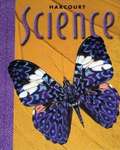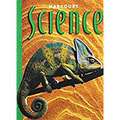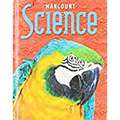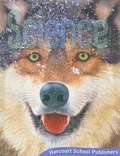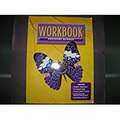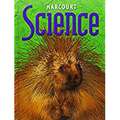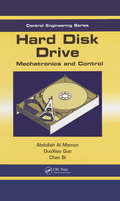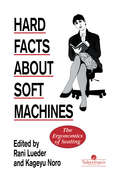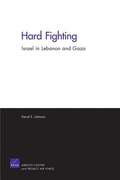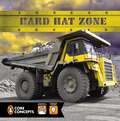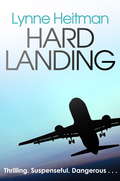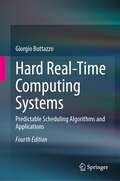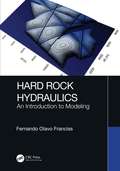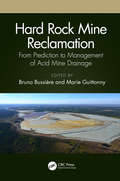- Table View
- List View
Harcourt Science (Grade #2)
by Harcourt School Publishers StaffLiving things need nonliving things. Plants need air, water, and light to grow. People and animals need air, food, and water to live.
Harcourt Science (Grade #4)
by Marjorie Slavick Frank Robert M. Jones Gerald H. Krockover Mozell P. Lang Joyce C. Mcleod Carol J. Valenta Barry A. Van DemanThis Harcourt Science deals with topics on A World of Living Things, Looking at Ecosystems, Earth's Surface, Patterns on Earth and In Space, Matter and Energy, Forces and Motion, etc.
Harcourt Science (Grade #4)
by Harcourt School PublishersWhen scientists try to find an answer to a question or do an experiment, they use thinking tools called process skills. You use many of the process skills whenever you speak, listen, read, write, or think. Think about how these students use process skills to help them answer questions, doe experiments, and investigate the world around them.
Harcourt Science (Grade #4)
by Harcourt School PublishersEvery chapter of this book contains lessons that entail scientific vocabularies, experiments, test preps and lesson reviews. The book also has a health handbook.
Harcourt Science (Grade #6)
by Marjorie Slavick Frank Robert M. Jones Gerald H. Krockover Mozell P. Lang Joyce C. Mcleod Carol J. Valenta Barry A. Van DemanScience textbook for 6th graders.
Harcourt Science (Grade 1, Texas edition)
by Harcourt School Publishers StaffThe oldest living thing on Earth is the bristle-cone pine tree in the United States.
Harcourt Science Workbook
by Harcourt School PublishersTopics broadly covered in this book include investigating matter, energy, forces, earth cycles, space, land, plants and animals.
Harcourt Science: Cycles on Earth and in Space (Grade #3)
by Marjorie Slavick Frank Robert M. Jones Gerald H. Krockover Mozell P. Lang Joyce C. Mcleod Carol J. Valenta Barry A. Van DemanThis book is your gateway to becoming a great scientist.
Harcourt Science: Earth's Surface (Grade #4)
by Marjorie Slavick Frank Robert M. Jones Gerald H. Krockover Mozell P. Lang Joyce C. Mcleod Carol J. Valenta Barry A. Van DemanThis book is your gateway to becoming a great scientist.
Harcourt Science: Grade 3
by Harcourt School Publishers StaffSpectrum Science is sure to captivate students' interest with a variety of fascinating science information! The lessons, perfect for students in grade 3, strengthen science skills by focusing on the metric system, states of matter, photosynthesis, gravity and planetary motion, medicine, and more! Each book features easy-to-understand directions, full-color illustrations, photos, and lively passages. It is aligned to national and state standards, and also includes a complete answer key. --Today, more than ever, students need to be equipped with the essential skills they need for school achievement and for success on proficiency tests. The Spectrum series has been designed to prepare students with these skills and to enhance student achievement. Developed by experts in the field of education, each title in the Spectrum workbook series offers grade-appropriate instruction and reinforcement in an effective sequence for learning success. Perfect for use at home or in school, and a favorite of parents, homeschoolers, and teachers worldwide, Spectrum is the learning partner students need for complete achievement.
Harcourt Science: Matter and Energy (Grade #4)
by Marjorie Slavick Frank Robert M. Jones Gerald H. Krockover Mozell P. Lang Joyce C. Mcleod Carol J. Valenta Barry A. Van DemanThis book is your gateway to becoming a great scientist.
Harcourt Science: Plants and Animals
by Marjorie Slavick Frank Robert M. Jones Gerald H. Krockover Mozell P. Lang Joyce C. Mcleod Carol J. Valenta Barry A. Van DemanScience textbook on plants and animals.
Harcourt Science: The Living Planet
by Marjorie Slavick Frank Robert M. Jones Gerald H. Krockover Mozell P. Lang Joyce C. Mcleod Carol J. Valenta Barry A. Van DemanScience textbook for children. The lead authors weave together content with hands-on science inquiry that's sure to reach every student.
Harcourt Science: Unit B Plants and Animals Interact (Grade #3)
by Marjorie Slavick Frank Robert M. Jones Gerald H. Krockover Mozell P. Lang Joyce C. Mcleod Carol J. Valenta Barry A. Van DemanThis book covers science in three broad topics: life science, earth science and physical science.
Hard Disk Drive: Mechatronics and Control (Automation and Control Engineering #23)
by Abdullah Al Mamun GuoXiao Guo Chao BiThe hard disk drive is one of the finest examples of the precision control of mechatronics, with tolerances less than one micrometer achieved while operating at high speed. Increasing demand for higher data density as well as disturbance-prone operating environments continue to test designers' mettle. Explore the challenges presented by modern hard disk drives and learn how to overcome them with Hard Disk Drive: Mechatronics and Control.Beginning with an overview of hard disk drive history, components, operating principles, and industry trends, the authors thoroughly examine the design and manufacturing challenges. They start with the head positioning servomechanism followed by the design of the actuator servo controller, the critical aspects of spindle motor control, and finally, the servo track writer, a critical technology in hard disk drive manufacturing. By comparing various design approaches for both single- and dual-stage servomechanisms, the book shows the relative pros and cons of each approach. Numerous examples and figures clarify and illustrate the discussion.Exploring practical issues such as models for plants, noise reduction, disturbances, and common problems with spindle motors, Hard Disk Drive: Mechatronics and Control avoids heavy theory in favor of providing hands-on insight into real issues facing designers every day.
Hard Facts About Soft Machines: The Ergonomics Of Seating
by Rani Lueder; Kageyu NoroAlthough work furniture has had so much more attention recently there is a long way to go before this is translated into action in the wider world. Increased international concern for the health and safety of people at work is one of the driving forces behind this book.; The Science of Seating brings together researchers in ergonomics and posture with industrial designers, to review and assess the current state of chair design, with implications for cultural, behavioural and occupational aspects of health. The contributions are a significant step in the science of seating and should lead to a better understanding of the mechanics, dynamics and the effects of seating on the sitter.; They point to ways in which seats might become easier-to-use and adjust, offering both comfort and postural support without compromising freedom of movement: and in the not-too-distant furture, "the intelligent chair" will "remember" the sitter's preferences for position, cushiness and so on.; Topics covered include: Adjustability, Anthropometics, Posture, Back Pain, Biomechanics, Seat Pressure Distributions, School children, Special Needs of Users, Design Applications, Industry Perspectives, VDT Standards.; It is aimed at researchers and practising seating designers, ergonomists, design engineers, occupational health workers and physiotherapists and furniture manufacturers.
Hard Fighting: Israel in Lebanon and Gaza
by David E. JohnsonLike Israel in 2006, the United States today is likely ill prepared for hybrid warfare. To identify lessons that the U. S. military might learn from the Israeli experience in Lebanon, the author examines the state of the Israeli military before the Second Lebanon War, the lessons it learned during that conflict, the reforms it undertook to address its deficiencies, and how it fared during Operation Cast Lead three years later.
Hard Hat Zone (Penguin Core Concepts)
by Theo BakerHard Hat Zone covers the concepts Community Workers & Helpers and Problem Solving.Construction sites are some of the most interesting places, especially for young boys. Join the workers as they use dump trucks, cranes, concrete mixers, backhoes, and payloaders to build a new skyscraper! Full of photographs, Hard Hat Zone is an exciting and informative read for children interested in how things are built.
Hard Landing: A gripping thriller set in a dangerous international airport (The\alex Shanahan Thrillers Ser. #1)
by Lynne HeitmanA gripping and fast-paced thriller introducing the resourceful and brilliant Alex Shanahan. Perfect for fans of Jeffery Deaver and James Patterson'Truly excellent . . . The best white-knuckle ride I've taken in a long time' LEE CHILD__________On a cold afternoon on the North Shore of Massachusetts, the body of Ellen Shepard is found. She leaves no family. She leaves no note. And she leaves vacant her position as the general manager of the notoriously brutal Majestic Airlines operation at Boston's airport.From the moment Alex Shanahan takes control of the operation, she is pulled into the menacing intrigue of her predecessor's death. She is welcomed by an obscene depiction of Ellen's dead body - a warning that secrets can kill and that once she knows them it will already too late.But Alex wants to know the truth. She follows the trail of corruption and betrayal from the loading ramp to the airline's executive suites. What she uncovers could bankrupt the airline and destroy the lives and careers of everyone involved. It could also cost Alex her life . . .__________Book 1 in the Alex Shanahan series
Hard Real-Time Computing Systems: Predictable Scheduling Algorithms and Applications
by Giorgio ButtazzoThis book is a basic treatise on real-time computing, with particular emphasis on predictable scheduling algorithms. The main objectives of the book are to introduce the basic concepts of real-time computing, illustrate the most significant results in the field, and provide the basic methodologies for designing predictable computing systems useful in supporting critical control applications.Hard Real-Time Computing Systems is written for instructional use and is organized to enable readers without a strong knowledge of the subject matter to quickly grasp the material. Technical concepts are clearly defined at the beginning of each chapter, and algorithm descriptions are corroborated through concrete examples, illustrations, and tables. This new, fourth edition includes new sections to explain the variable-rate task model, how to improve predictability and safety in cyber-physical real-time systems that exploit machine learning algorithms, additional coverage on Response Time Analysis, and a new chapter on implementing periodic real-time tasks under Linux..
Hard Rock Hydraulics: An Introduction to Modeling
by Fernando Olavo FrancissHard rock hydraulics concerns arrangements of adjoining intact rock blocks, occurring down to a depth of hundreds of meters, where groundwater percolates within the gaps between these blocks. During the last decades, technical papers related to successful or failed attempts for mining groundwater from hard rocks, and achievements or failures of public or mining developments with respect to these rocks, increased the knowledge of their hydraulics. Examples of activities where the mechanical behavior of these rocks highly interacts with their hydraulics are projects under the sea or groundwater level, such as open pits or underground mines, galleries, tunnels, shafts, underground hydropower plants, oil and LPG storage caverns, and deep disposal of hazardous waste. This book dedicated to hard rock hydraulics assumes some prior knowledge of hydraulics, geology, hydrogeology, and soil and rock mechanics. Chapter I discusses the main issues of modeling; chapter II covers the fundamentals of hard rock hydraulics; chapter III presents concepts regarding approximate solutions; chapter IV discusses data analysis for groundwater modeling; chapter V focuses on finite differences and chapter VI provides examples of some particular unusual applications. This book will help civil and mining engineers and also geologists to solve their practical problems in hydrogeology and public or mining projects.
Hard Rock Mine Reclamation: From Prediction to Management of Acid Mine Drainage
by Bruno Bussière Marie GuittonnyHard rock mines have significant effects on the territories where they operate, through both infrastructure construction as well as resource use. Due to their extractive activities, these mines store large quantities of wastes at the surface, which can be both physically and chemically unstable. Reclamation aims to return a mine site to a satisfactory state, meaning that the site should not threaten human health or security, should not generate in the long term any contaminant that could significantly affect the surrounding environment, and should be aesthetically acceptable to communities. This book focuses on the reclamation of waste storage areas, which constitute the main source of pollution during and after mine operations, and especially issues with acid mine drainage and neutral contaminated drainage. Features: Provides fundamental information and describes practical methods to reclaim mine-waste facilities Compares the different methods and illustrates their application at sites through case studies Identifies new reclamation issues and proposes solutions to address them Presents existing and new technologies to reclaim mine waste disposal areas from hard rock mines in different climatic conditions Integrates reclamation into mine operations and long term performance of techniques used through an interdisciplinary approach With mine site reclamation a young and still emerging science, the training needs for professionals and students working in this field are huge. This book is written from an engineering point of view and in it the authors identify new reclamation issues and propose well-tested as well as innovative approaches to addressing them. Students in graduate programs focused on mines and the environment as well as professionals already working in departments related to mine site reclamation will find this book to be a valuable and essential resource.

